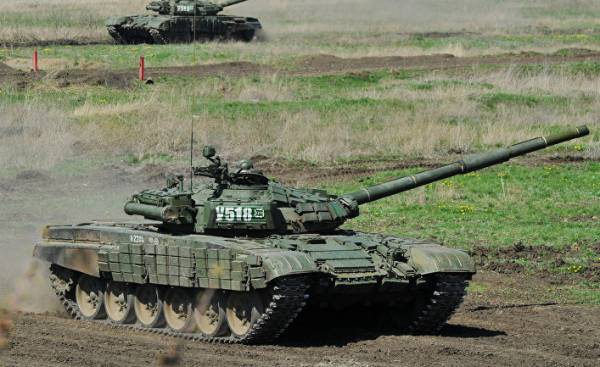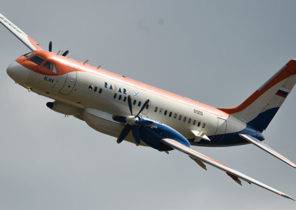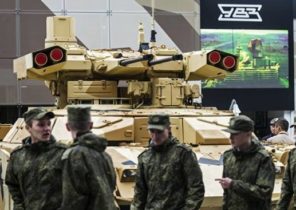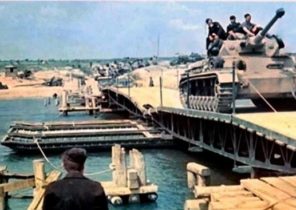
In recent years, new Russian tank T-14 “Armata” has attracted a lot of interest worldwide. He has a design “from scratch”, and this is a fundamentally new Soviet and Russian tank, which was not for many years. Despite the approaching deadlines for the adoption of “Almaty was” adopted, the budget problems will lead to that Russian armored troops for the most part will consist of the old and well-known cars that appeared in the 1980-ies and even earlier.
Currently, Russia has the troops there are 2 700 tanks. They are divided into 36 separate motorized rifle (mechanized) and tank brigades and four motorized infantry and tank divisions. A relatively new invention in the Russian army are so-called battalion tactical groups. This reinforced combined arms unit capable of independent combat operations, consisting of four armored and mechanized infantry mouth, and artillery, reconnaissance, engineer and support units. Every Russian combat brigade or regiment there are about two battalion tactical groups.
The basis of modern tank forces in Russia still constitutes a family of T-72 tanks, which includes this very car, its a relative of the T-80 and an older brother T-90. The oldest model T-72 — thirty years. T-80 a little younger because it was constructed at the end of the cold war. The new tank — T-90, which at its core is a deep modernization of T-72.
T-72, adopted in 1973, caused a shock in the NATO countries. It was a tank with a low rise, with a new, powerful guns and strong armor. It is very different from the outdated T-62. A new 125-mm tank gun 2A46M could make up to eight shots per minute, she had the autoloader replaced the loader, and thus the tower the tank was less despite an increase in caliber guns and quantities of ammunition. Diesel engine capacity of 780 horsepower enabled the car to have a road speed of 60 kilometers per hour.
T-72 was good for its time armor protection. Composite armor hull and turret provide a protective capability equivalent to 335 to 380 millimeters of rolled homogeneous steel armour, which provides protection from 120-millimeter armor-piercing shells feathered NATO with detachable tray. And its protective ability against ke rounds of the same caliber was equal to 410-450 mm. In a later version of T-72B1 50% were enhanced protection against armor-piercing shells. And thanks to the set of dynamic protection “Kontakt-1” protection against cumulative projectiles were almost doubled. In the middle 1980s, a better set of “Kontakt-5”, which effectively protects the car from the TOW ATGM and heavy anti-tank missiles.
T-72 was the main tank in the Soviet Army until the end of the cold war, and large quantities were shipped abroad in 12 countries, including Syria and Iraq. During the invasion of Lebanon in 1982, Syrian T-72 has shown himself weak against Israel’s tanks, and the Iraqis in their cars during the 1991 war fought worse. This is mainly due to low level of preparedness of the crews of the Syrian and Iraqi armies, but the T-72 had its own flaws and is inferior to modern Western and Israeli cars, especially ammunition for tank guns, fire control system, night vision devices, and armor protection. It is very important that the Iraqi T-72 was not dynamic protection type “Contact-1” and “Kontakt-5”.
In addition to a T-72 Russian army inherited the T-80. He looks very similar to the T-72 having the same gun 2A46M. But between them was significant differences. Gun T-80 could fire cumulative ammunition 9M112 “Cobra”, which had a range of four kilometers and could penetrate the armor thickness to 700 millimeters. T-80 was a bit bigger, and it had a gas turbine engine power 1 250 HP, which provided greater maneuverability, but at the expense of reliability.
The Russian economic hardship in the 1990s and early 2000-ies has led to the fact that the country’s armed forces were underfunded. Money for a new tank was not, and the best examples of T-72 and T-80 remained in service, undergoing numerous upgrades.
Despite the demoralizing effect of the Gulf war in 1991, the Soviet engineers have created many modifications, using their innovative approaches to the improvement of obsolete tanks. Complex electro-optical active protection “Blind-1” had sensors to detect anti-tank guided missiles infrared guidance and launchers smoke grenades to protect tank missiles with laser guidance. The complex of active protection “arena” had in its composition the Doppler radar and the protective ammunition for the destruction of anti-tank guided rockets and missiles at short range. Tank gun 2A46M got a new cumulative and armor-piercing ammunition with greater penetration ability, and remaining in the armed forces of tanks T-80 was equipped with a complex tank missile 9M119 “Refleks”, which is much better than “Cobra”.
In today’s generation of tanks T-72B3 all these improvements combined, and the tank was very modern. It is equipped with the latest integrated dynamic protection “Contact-5”, which protects it from heat shells. From a tank gun you can keep shooting missiles 9M119 Reflex, and the ammunition of the machine is increased from 39 to 45 shells. As a result, the T-72B3 has received many performance improvements on armor and protection (setup of the new engine was cancelled in order to save). In the future T-72B will be modernised and will receive automatic tracking and fire control system installed on the tank “Armata”, a new set of dynamic protection “Relic” and a new diesel engine, whose power will be 50% more compared with the previous power plants.
The rest of the Russian army 550 T-80 tanks are being upgraded to the level of T-80BV. This tank is basically identical to the T-72Б3в terms of weapons and armor protection, but it is more reliable, though less powerful gas turbine engine. According to information from the reference book Jane’s, T-80BV is more suitable for cold climatic conditions of the Far East, Siberia and the Arctic. Perhaps it is no coincidence that these places are the furthest from the tank forces of the NATO countries.
After the fall of the Berlin wall in 1993, he was adopted by one of the “new” Russian tank. This Is The T-90. In fact, this is a modernised T-72, but he was presented as a completely new car. In many respects, the T-90 similar to the modern T-72B3, and it marked the beginning of large-scale project of modernization of T-72. In the latest version the T-90MS has all the features of the T-72B3, plus the diesel engine of a thousand horse power, of the camera to ensure awareness of tankers on the environment, as well as GLONASS. One of the most important features of the T-90 is more powerful armor, defensive ability is equivalent to 690 millimeters against piercing and 1 040 mm against shaped charge warheads. Due to additional layers of steel and of composite materials on the turret and chassis, and thanks to the latest generation of dynamic protection armor protection of T-90 is twice as powerful than the T-72.
The high cost of the tank “Armata” combined with Western sanctions imposed over Russia’s invasion of Ukraine in 2014 will certainly hurt Moscow to create these new vehicles in large quantities. In the Russian armed forces many outdated military equipment, ranging from fighter jets and tanks, and armored vehicles to new generations. Despite the process of modernization, there will be a large number of old weapons. But with the proper maintenance, repair and modernization of old tanks will be able to serve in the Russian army, more than a dozen years.
Kyle Mizokami is a specialist in the field of defense and national security. Lives and works in San Francisco, and his articles are published in such publications as the Diplomat, Foreign Policy, War is Boring and the Daily Beast. In 2009, he became one of the founders of the blog Japan Security Watch.







